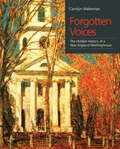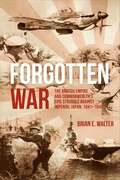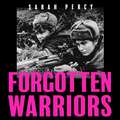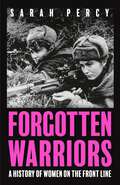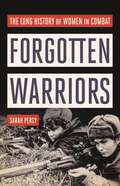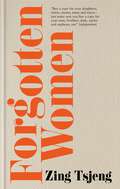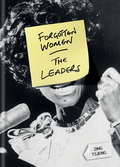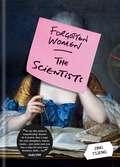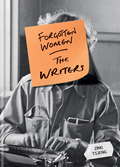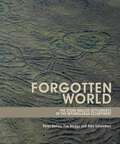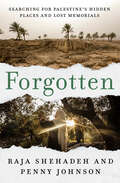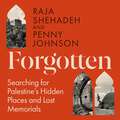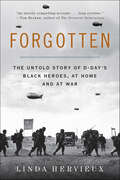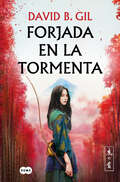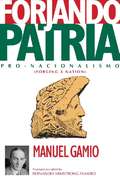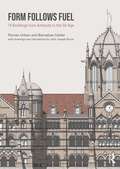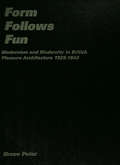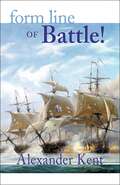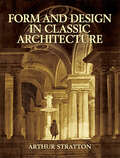- Table View
- List View
Forgotten Voices: The Hidden History of a New England Meetinghouse (The Driftless Series)
by Carolyn WakemanThe history inscribed in New England's meetinghouses waits to be told. There, colonists gathered for required worship on the Sabbath, for town meetings, and for court hearings. There, ministers and local officials, many of them slave owners, spoke about salvation, liberty, and justice. There, women before the Civil War found a role and a purpose outside their households. This innovative exploration of a coastal Connecticut town, birthplace of two governors and a Supreme Court Chief Justice, retrieves the voices preserved in record books and sermons and the intimate views conveyed in women's letters. Told through the words of those whose lives the meetinghouse shaped, Forgotten Voices uncovers a hidden past. It begins with the displacement of Indigenous people in the area before Europeans arrived, continues with disputes over worship and witchcraft in the early colonial settlement, and looks ahead to the use of Connecticut's most iconic white church as a refuge and sanctuary. Relying on the resources of local archives, the contents of family attics, and the extensive records of the Congregational Church, this community portrait details the long ignored genocide and enslaved people and reshapes prevailing ideas about history's makers. Meticulously researched and including 75 color illustrations, Forgotten Voices will be of interest to anyone exploring the roots of community life in New England.The book is the joint project of the Old Lyme meetinghouse and the Florence Griswold Museum. The museum will host a major exhibit in 20192020, exploring the role of the meetinghouse.
Forgotten War: The British Empire and Commonwealth’s Epic Struggle Against Imperial Japan, 1941–1945
by Brian E. WalterA new assessment of the British and Commonwealth contribution to the defeat of Japan in the Pacific. The monumental struggle fought against Imperial Japan in the Asia/Pacific theater during World War II is primarily viewed as an American affair. While the United States did play a dominant role, the British and Commonwealth forces also made major contributions—on land, at sea and in the air, eventually involving over a million men and vast armadas of ships and aircraft. It was a difficult and often desperate conflict fought against a skilled and ruthless enemy that initially saw the British suffer the worst series of defeats ever to befall their armed forces. Still, the British persevered and slowly turned the tables on their Japanese antagonists. Fighting over an immense area that stretched from India in the west to the Solomon Islands in the east and Australia in the south to the waters off Japan in the north, British and Commonwealth forces eventually scored a string of stirring victories that avenged their earlier defeats and helped facilitate the demise of the Japanese Empire. Often overlooked by history, this substantial war effort is fully explored in Forgotten War. Meticulously researched, the book provides a complete, balanced and detailed account of the role that British and Commonwealth forces played on land, sea and in the air during this crucial struggle. It also provides unique analysis regarding the effectiveness and relevance of this collective effort and the contributions it made to the overall Allied victory.
Forgotten Warriors: A History of Women on the Front Line
by Sarah PercyFrom the Amazons to the Ukraine conflict, women have always been on the frontline of war: this is their surprising and heroic history.Battlefields have always contained a surprising number of women. Tracing the long history of female fighters, Forgotten Warriors puts the record straight, exploring how war became an all-male space, and getting to the bottom of why women were allowed to be astronauts a full thirty years before they were allowed to fight in combat.From the Mino, the all-female army that protected Dahomey from the West for two hundred years to the Night Witches, Soviet flying aces that decimated the Nazis; from the real story of Joan of Arc to the cross-dressing soldiers whose disguises were so effective the men around them never realized who they were fighting with, Sarah Percy shines a fascinating new light on the history of warfare. And against a backdrop of sieges and desperate battles, rebellions and civil wars, a series of extraordinary women come alive on the page, determined not to be passive victims.Every country has their tomb to the unknown warrior, picking out one unnamed body to represent the sacrifices of thousands of others. As Forgotten Warriors shows, those overlooked soldiers could well be female. Their heroic and compelling stories need to be heard.(P) 2023 Hodder & Stoughton Limited
Forgotten Warriors: A History of Women on the Front Line
by Sarah PercyFrom Boudicca to Ukraine, battlefields have always contained a surprising number of women. Tracing the long history of female fighters, Forgotten Warriors puts the record straight, exploring how war became an all-male space, and getting to the bottom of why women were allowed to be astronauts a full thirty years before they were allowed to fight in combat.From the Mino, the all-female army that protected Dahomey from the West for two hundred years to the Night Witches, Soviet flying aces that decimated the Nazis; from the real story of Joan of Arc to the cross-dressing soldiers whose disguises were so effective the men around them never realized who they were fighting with, Sarah Percy shines a fascinating new light on the history of warfare. And against a backdrop of sieges and desperate battles, rebellions and civil wars, a series of extraordinary women come alive on the page, determined not to be passive victims.Every country has their tomb to the unknown warrior, picking out one unnamed body to represent the sacrifices of thousands of others. As Forgotten Warriors shows, those overlooked soldiers could well be female. Their heroic and compelling stories need to be heard.
Forgotten Warriors: The Long History of Women in Combat
by Sarah PercyThe definitive history of women in war, revealing how women have always been an essential part of combat From Boudicca&’s rebellion to the war in Ukraine, battlefields have always contained a surprising number of women. Some formed all-female armies, like the Dahomey Mino of West Africa; some fought disguised as men; some mobilized in times of national survival, like the Soviet flying aces known as the Night Witches. International relations expert Sarah Percy unearths the stories of these forgotten warriors. She sets the historical record straight, revealing that women&’s exclusion from active combat in the late nineteenth and early twentieth centuries is a blip in a much longer narrative of female inclusion. Deeply researched and brilliantly told, Forgotten Warriors turns the notion of war as a man&’s game on its head and restores women to their rightful place on the front lines of history.
Forgotten Wars: Central and Eastern Europe, 1912–1916 (Studies in the Social and Cultural History of Modern Warfare)
by Włodzimierz Borodziej Maciej GórnyWłodzimierz Borodziej and Maciej Górny set out to salvage the historical memory of the experience of war in the lands between Riga and Skopje, beginning with the two Balkan conflicts of 1912–1913 and ending with the death of Emperor Franz Joseph in 1916. The First World War in the East and South-East of Europe was fought by people from a multitude of different nationalities, most of them dressed in the uniforms of three imperial armies: Russian, German, and Austro-Hungarian. In this first volume of Forgotten Wars, the authors chart the origins and outbreak of the First World War, the early battles, and the war's impact on ordinary soldiers and civilians through to the end of the Romanian campaign in December 1916, by which point the Central Powers controlled all of the Balkans except for the Peloponnese. Combining military and social history, the authors make extensive use of eyewitness accounts to describe the traumatic experience that established a region stretching between the Baltic, Adriatic, and Black Seas.
Forgotten Women
by Zing Tsjeng'To say this [book] is "empowering" doesn't do it justice. Buy a copy for your daughters, sisters, mums, aunts and nieces - just make sure you buy a copy for your sons, brothers, dads, uncles and nephews, too.' - indy100'Here's to no more forgotten women.' - Evening StandardForgotten Women reaches around the world and its history to rediscover, retell and reinstate the lives of over 190 important and significant women. From Neolithic times to modernity, Zing Tsjeng has traced the women who have shaped their age and revolutionised society. In this book lies the strength, lives and sacrifices of women who have refused to accept the hand they've been dealt and have changed the course of our futures accordingly.
Forgotten Women
by Zing Tsjeng'To say this [book] is "empowering" doesn't do it justice. Buy a copy for your daughters, sisters, mums, aunts and nieces - just make sure you buy a copy for your sons, brothers, dads, uncles and nephews, too.' - indy100'Here's to no more forgotten women.' - Evening StandardForgotten Women reaches around the world and its history to rediscover, retell and reinstate the lives of over 190 important and significant women. From Neolithic times to modernity, Zing Tsjeng has traced the women who have shaped their age and revolutionised society. In this book lies the strength, lives and sacrifices of women who have refused to accept the hand they've been dealt and have changed the course of our futures accordingly.
Forgotten Women: The Artists (Forgotten Women)
by Zing Tsjeng'To say this series is "empowering" doesn't do it justice. Buy a copy for your daughters, sisters, mums, aunts and nieces - just make sure you buy a copy for your sons, brothers, dads, uncles and nephews, too.' - IndependentThe women who shaped and were erased from our history.Forgotten Women is a new series of books that uncover the lost herstories of influential women who have refused over hundreds of years to accept the hand they've been dealt and, as a result, have formed, shaped and changed the course of our futures.The Artists brings together the stories of 48* brilliant woman artists who made huge yet unacknowledged contributions to the history of art, including Camille Claudel, the extraordinarily talented sculptor who was always unfairly overshadowed by her lover, Rodin; Baroness Elsa von Freytag-Loringhoven, who has been claimed as the true originator of Marcel Duchamp's Fountain; and Ana Mendieta, the Cuban refugee who approached violence against women through her performance art before her own untimely death. With chapters ranging from Figurative to Photography, and Craft to Conceptual, this is an alternative guide to art history that demonstrates the broad range of artistic movements that included, and were often pioneered by, female artists who have been largely overlooked.*The number of Nobel-prize-winning women.
Forgotten Women: The Leaders (Forgotten Women Ser.)
by Zing Tsjeng'To say this series is "empowering" doesn't do it justice. Buy a copy for your daughters, sisters, mums, aunts and nieces - just make sure you buy a copy for your sons, brothers, dads, uncles and nephews, too.' - indy100The women who shaped and were erased from our history.The Forgotten Women series will uncover the lost histories of the influential women who have refused over hundreds of years to accept the hand they've been dealt and, as a result, have formed, shaped and changed the course of our futures. The Leaders weaves together 48* unforgettable portraits of the true pioneers and leaders who made huge yet unacknowledged contributions to history, including:Grace O'Malley, the 16th century Irish pirate queenSylvia Rivera, who spearheaded the modern transgender rights movementAgent 355, the unknown rebel spy who played a pivotal role in the American RevolutionNoor Inayat Khan, who went undercover to spy for the French Resistance and became Nazi enemy no. 1Amina of Zazzau, the formidable ancient Muslim warrior queen of Northern NigeriaChapters including Rebels; Warriors; Rulers; Activists and Reformers shine a spotlight on the rebellious women who defied the odds, and the opposition, to change the world around them. *The number of Nobel-prize-winning women.
Forgotten Women: The Leaders (Forgotten Women)
by Zing TsjengSelected for the Evening Standard present gift guide of the year'To say this series is "empowering" doesn't do it justice. Buy a copy for your daughters, sisters, mums, aunts and nieces - just make sure you buy a copy for your sons, brothers, dads, uncles and nephews, too.' - indy100'Here's to no more forgotten women.' Evening StandardThe women who shaped and were erased from our history.The Forgotten Women series will uncover the lost histories of the influential women who have refused over hundreds of years to accept the hand they've been dealt and, as a result, have formed, shaped and changed the course of our futures. The Leaders weaves together 48* unforgettable portraits of the true pioneers and leaders who made huge yet unacknowledged contributions to history, including:Grace O'Malley, the 16th century Irish pirate queenSylvia Rivera, who spearheaded the modern transgender rights movementAgent 355, the unknown rebel spy who played a pivotal role in the American RevolutionNoor Inayat Khan, who went undercover to spy for the French Resistance and became Nazi enemy no. 1Amina of Zazzau, the formidable ancient Muslim warrior queen of Northern NigeriaChapters including Rebels; Warriors; Rulers; Activists and Reformers shine a spotlight on the rebellious women who defied the odds, and the opposition, to change the world around them. *The number of Nobel-prize-winning women.
Forgotten Women: The Scientists (Forgotten Women)
by Zing Tsjeng Zhi Ying Tsjeng'To say this series is "empowering" doesn't do it justice. Buy a copy for your daughters, sisters, mums, aunts and nieces - just make sure you buy a copy for your sons, brothers, dads, uncles and nephews, too.' - indy100'Here's to no more forgotten women.' Evening StandardThe women who shaped and were erased from our history.The Forgotten Women series will uncover the lost histories of the influential women who have refused over hundreds of years to accept the hand they've been dealt and, as a result, have formed, shaped and changed the course of our futures. The Scientists celebrates 48* unsung scientific heroines whose hugely important, yet broadly unacknowledged or incorrectly attributed, discoveries have transformed our understanding of the scientific world. Mary Anning, the amateur paleontologist whose fossil findings changed scientific thinking about prehistoric life Emmy Noether, dubbed "The Mighty Mathematician You've Never Heard Of"Ynés Mexía, the Mexican-American botanist who discovered over 500 new plant species Wangari Maathai, who started an environmental and ecological revolution in KenyaMargaret Sanger, the maverick nurse who paved the way for the legalization of contraceptionChapters including Earth & Universe; Biology & Natural Sciences; Medicine & Psychology; Physics & Chemistry; Mathematics and Technology & Inventions profile the female scientists who have defied the odds, and the opposition, to change the world around us.*The number of Nobel-prize-winning women.
Forgotten Women: The Scientists (Forgotten Women)
by Zing Tsjeng Zhi Ying Tsjeng'To say this series is "empowering" doesn't do it justice. Buy a copy for your daughters, sisters, mums, aunts and nieces - just make sure you buy a copy for your sons, brothers, dads, uncles and nephews, too.' - indy100'Here's to no more forgotten women.' Evening StandardThe women who shaped and were erased from our history.The Forgotten Women series will uncover the lost histories of the influential women who have refused over hundreds of years to accept the hand they've been dealt and, as a result, have formed, shaped and changed the course of our futures. The Scientists celebrates 48* unsung scientific heroines whose hugely important, yet broadly unacknowledged or incorrectly attributed, discoveries have transformed our understanding of the scientific world. Mary Anning, the amateur paleontologist whose fossil findings changed scientific thinking about prehistoric life Emmy Noether, dubbed "The Mighty Mathematician You've Never Heard Of"Ynés Mexía, the Mexican-American botanist who discovered over 500 new plant species Wangari Maathai, who started an environmental and ecological revolution in KenyaMargaret Sanger, the maverick nurse who paved the way for the legalization of contraceptionChapters including Earth & Universe; Biology & Natural Sciences; Medicine & Psychology; Physics & Chemistry; Mathematics and Technology & Inventions profile the female scientists who have defied the odds, and the opposition, to change the world around us.*The number of Nobel-prize-winning women.
Forgotten Women: The Writers (Forgotten Women)
by Zing Tsjeng'To say this series is "empowering" doesn't do it justice. Buy a copy for your daughters, sisters, mums, aunts and nieces - just make sure you buy a copy for your sons, brothers, dads, uncles and nephews, too.' - IndependentThe women who shaped and were erased from our history.Forgotten Women is a new series of books that uncover the lost herstories of influential women who have refused over hundreds of years to accept the hand they've been dealt and, as a result, have formed, shaped and changed the course of our futures. The Writers celebrates 48* unsung genius female writers from throughout history and across the world, including the Girl Stunt Reporters, who went undercover to write exposés on the ills of 1890s America; Aemilia Lanyer, the contemporary of Shakespeare whose polemical re-writing of The Bible's Passion Story is regarded as one of the earliest feminist works of literature; and Sarojini Naidu, the freedom fighter and 'Nightingale of India' whose poetry echoed her political desire for Indian independence.Including writers from across a wide spectrum of disciplines including poets, journalists, novelists, essayists and diarists, this is an alternative gynocentric history of literature that will surprise, empower, and leave you with a reading list a mile long.*The number of Nobel-prize-winning women.
Forgotten World: The Stone-Walled Settlements of the Mpumalanga Escarpment
by Peter Delius Tim Maggs Alex SchoemanIf you drive through Mpumalanga with an eye on the landscape flashing by, you may see, near the sides of the road and further away on the hills above and in the valleys below, fragments of building in stone as well as sections of stone-walling breaking the grass cover. Endless stone circles, set in bewildering mazes and linked by long stone passages, cover the landscape stretching from Ohrigstad to Carolina, connecting over 10 000 square kilometres of the escarpment into a complex web of stone-walled homesteads, terraced fields and linking roads. Oral traditions recorded in the early twentieth century named the area Bokoni – the country of the Koni people. Few South Africans or visitors to the country know much about these settlements, and why today they are deserted and largely ignored. A long tradition of archaeological work which might provide some of the answers remains cloistered in universities and the knowledge vacuum has been filled by a variety of exotic explanations – invoking ancient settlers from India or even visitors from outer space – that share a common assumption that Africans were too primitive to have created such elaborate stone structures. Forgotten World defies the usual stereotypes about backward African farming methods and shows that these settlements were at their peak between 1500 and 1820, that they housed a substantial population, organised vast amounts of labour for infrastructural development, and displayed extraordinary levels of agricultural innovation and productivity. The Koni were part of a trading system linked to the coast of Mozambique and the wider world of Indian Ocean trade beyond. Forgotten World tells the story of Bokoni through rigorous historical and archaeological research, and lavishly illustrates it with stunning photographic images.
Forgotten: Searching for Palestine's Hidden Places and Lost Memorials
by Raja Shehadeh Penny JohnsonA profound meditation on memory and the preservation of Palestinian heritage, from the award-winning author of We Could Have Been Friends, My Father and I.Forgotten uncovers the hidden or neglected memorials and places in historic Palestine—now Israel and the Occupied Palestinian Territories—and what they might tell us about the land and the people who live on the small slip of earth between the Mediterranean Sea and the Jordan River.From ancient city ruins to the Nabi 'Ukkasha mosque and tomb, acclaimed writers and researchers Raja Shehadeh and Penny Johnson ask: what has been memorialized, and what lies unseen, abandoned, or erased—and why? Whether standing on a high cliff overlooking Lebanon or at the lowest land-based elevation on earth at the Dead Sea, they explore lost connections in a fragmented land.In elegiac, elegant prose, Shehadeh and Johnson grapple not only with questions of Israeli resistance to acknowledging the Nakba—the 1948 catastrophe for Palestinians—but also with the complicated history of Palestinian commemoration today.
Forgotten: Searching for Palestine’s Hidden Places and Lost Memorials
by Raja Shehadeh Penny JohnsonForgotten is a search for hidden or neglected memorials and places in historic Palestine - now Israel and the Occupied Palestinian Territories - and what they might tell us about the land and the people who live on our small slip of earth between the Mediterranean Sea and the Jordan River.From ancient city ruins to the Nabi 'Ukkasha mosque and tomb, acclaimed writers and researchers Raja Shehadeh and Penny Johnson ask: what has been memorialised, and what lies unseen, abandoned or erased - and why? Whether standing on a high cliff overlooking Lebanon or at the lowest land-based elevation on earth at the Dead Sea, they explore lost connections in a fragmented land.In elegiac, elegant prose, Shehadeh and Johnson grapple not only with questions of Israeli resistance to acknowledging the Nakba - the 1948 catastrophe for Palestinians - but also with the complicated history of Palestinian commemoration today.
Forgotten: The Untold Story of D-Day's Black Heroes, at Home and at War
by Linda Hervieux"An utterly compelling account of the African Americans who played a crucial and dangerous role in the invasion of Europe. The story of their heroic duty is long overdue.” —Tom Brokaw, author of The Greatest GenerationThe injustices of 1940s Jim Crow America are brought to life in this extraordinary blend of military and social history—a story that pays tribute to the valor of an all-Black battalion whose crucial contributions at D-Day have gone unrecognized to this day.In the early hours of June 6, 1944, the 320th Barrage Balloon Battalion, a unit of African-American soldiers, landed on the beaches of France. Their orders were to man a curtain of armed balloons meant to deter enemy aircraft. One member of the 320th would be nominated for the Medal of Honor, an award he would never receive. The nation’s highest decoration was not given to Black soldiers in World War II.Drawing on newly uncovered military records and dozens of original interviews with surviving members of the 320th and their families, Linda Hervieux tells the story of these heroic men charged with an extraordinary mission, whose contributions to one of the most celebrated events in modern history have been overlooked. Members of the 320th—Wilson Monk, a jack-of-all-trades from Atlantic City; Henry Parham, the son of sharecroppers from rural Virginia; William Dabney, an eager 17-year-old from Roanoke, Virginia; Samuel Mattison, a charming romantic from Columbus, Ohio—and thousands of other African Americans were sent abroad to fight for liberties denied them at home. In England and Europe, these soldiers discovered freedom they had not known in a homeland that treated them as second-class citizens—experiences they carried back to America, fueling the budding civil rights movement.In telling the story of the 320th Barrage Balloon Battalion, Hervieux offers a vivid account of the tension between racial politics and national service in wartime America, and a moving narrative of human bravery and perseverance in the face of injustice.
Forjada en la tormenta
by David B. GilUn cuento japonés de crimen y misterio por el autor de El guerrero a la sombra del cerezo Asaemon Hikura, maestro rastreador del clan Sugawara, es reclamado para investigar la desaparición de cinco mujeres en una aldea alejada de la capital. Los lugareños culpan de la desgracia a una criatura sobrenatural que, dicen, habita la montaña, pero Asaemon sabe bien que no existe demonio más cruel que aquel que vive entre nosotros. Acompañado de Yumiko, una joven cazadora local que le servirá de guía y confidente, el samurái se lanzará a una búsqueda desesperada. En la misma región, Nanami, hija de un forjador de katanas, trata de ocultar su romance con el joven samurái que administra su aldea. Una relación que contraviene la ley y la voluntad de sus padres. Cuando la guerra llama a sus puertas, Nanami se ve obligada a elegir entre la lealtad hacia su familia y la persona a la que se sabe unida por el karma. Sudecisión influirá de forma insospechada en el destino de las cinco jóvenes desaparecidas. Un relato policiaco con una ambientación insólita, enmarcado en un Japón rural de sugerentes paisajes y oscuros secretos, de la mano del autor que ha puesto de moda la épica samurái en la novela histórica española.
Forjando Patria
by Fernando Armstrong-Fumero Manuel GamioOften considered the father of anthropological studies in Mexico, Manuel Gamio originally published Forjando Patria in 1916. This groundbreaking manifesto for a national anthropology of Mexico summarizes the key issues in the development of anthropology as an academic discipline and the establishment of an active field of cultural politics in Mexico. Written during the upheaval of the Mexican Revolution, the book has now been translated into English for the first time. Armstrong-Fumero's translation allows readers to develop a more nuanced understanding of this foundational work, which is often misrepresented in contemporary critical analyses. As much about national identity as anthropology, this text gives Anglophone readers access to a particular set of topics that have been mentioned extensively in secondary literature but are rarely discussed with a sense of their original context. Forjando Patria also reveals the many textual ambiguities that can lend themselves to different interpretations. The book highlights the history and development of Mexican anthropology and archaeology at a time when scholars in the United States are increasingly recognizing the importance of cross-cultural collaboration with their Mexican colleagues. It will be of interest to anthropologists and archaeologists studying the region, as well as those involved in the history of the discipline.
Forjando Patria: Pro-Nacionalismo
by Manuel GamioOften considered the father of anthropological studies in Mexico, Manuel Gamio originally published Forjando Patria in 1916. This groundbreaking manifesto for a national anthropology of Mexico summarizes the key issues in the development of anthropology as an academic discipline and the establishment of an active field of cultural politics in Mexico. Written during the upheaval of the Mexican Revolution, the book has now been translated into English for the first time. Armstrong-Fumero's translation allows readers to develop a more nuanced understanding of this foundational work, which is often misrepresented in contemporary critical analyses. As much about national identity as anthropology, this text gives Anglophone readers access to a particular set of topics that have been mentioned extensively in secondary literature but are rarely discussed with a sense of their original context. Forjando Patria also reveals the many textual ambiguities that can lend themselves to different interpretations. The book highlights the history and development of Mexican anthropology and archaeology at a time when scholars in the United States are increasingly recognizing the importance of cross-cultural collaboration with their Mexican colleagues. It will be of interest to anthropologists and archaeologists studying the region, as well as those involved in the history of the discipline.
Form Follows Fuel: 14 Buildings from Antiquity to the Oil Age
by Barnabas Calder Florian UrbanModernists believed that “form follows function.” Form Follows Fuel shows that in fact energy has been the biggest influence on the world’s architecture throughout the history of our species. The availability of energy under different fuel regimes – including human labour, firewood, coal, oil, gas, and renewables – shapes architecture at all scales, from what gets built to how its doors hinge.This book is the first to quantify energy inputs for a range of buildings worldwide and across the historical record. In the process, it challenges today's architects, offers practical solutions to today's ecological crises, and highlights the aspects of today’s buildings that make architecture responsible for 37% of human climate-changing emissions. It reveals the enormously lower impacts of historical alternatives to today’s default building practices.This book shows that the shift to modern fossil fuel use, from the seventeenth century, came to be the most consequential move in the history of architecture as well as in human history in general. This brought about remarkable wealth for the built environment and at the same time unprecedented dangers for our planet, as evidenced by the exacerbating climate emergency.This book consists of 14 accessibly written case studies, illustrated with beautiful and revealing new measured drawings of each project by John Joseph Burns. Each chapter focuses on a single structure in a particular historical context, sometimes contrasted to similar buildings, from subsistence farming to advanced global capitalism. The chapters analyse the consumption of embodied and operational energy in these buildings, and also discuss questions of recycling and adaptive reuse. They complement precise descriptions with hard numbers on materials and construction, using robustly sourced approximations where exact figures are not available. The case studies rely on both published research and the authors’ own calculations and allow systematic comparison across different global regions and historical periods.Cases include architectural icons such as the Great Pyramid of Giza, the Baths of Caracalla, the Mausoleum of Qin Shi Huang, the Seagram Building, and Terminal 1 of Kuala Lumpur International Airport, as well as common types such as a pre-modern stone house, a late-nineteenth-century tenement, and a modernist panel block. Examples are taken from different regions of the world, including ancient China, pre-Columbian Mexico, and modern Europe. This book is an important contribution to architectural historical research, written for students, academics and building professionals as well as for a general audience.
Form Follows Fun: Modernism and Modernity in British Pleasure Architecture 1925–1940
by Bruce PeterAuthoritative and readable, this excellent text, illustrated by a unique pictorial record of period architecture, surveys and examines how and why the architecture of pleasure related to the stylistic and ideological concerns of modernism in 1930s Britain. Responding to the current interest in modernism and packed with a substantial archive of high quality photographs and other documentation, it relates the professional, entrepreneurial and institutional infrastructures affecting the pleasure industry’s architectural development and appearance in 1930s. A broad range of building through which the general public first experienced Modernism are covered, including: commercial – holiday camps, cinemas and greyhound racing stadia municipal and governmental projects – zoos, seaside pavilions, concert halls, and imperial and international exhibitions. Arguing that the responses to modernism through the architecture of pleasure were conditioned by wider debates about the role of design in relation to high and mass culture, this book is an ideal resource for all those interested in architectural history and design in Britain between the wars.
Form Line of Battle (The Richard Bolitho Novels #9)
by Alexander KentThe YEAR IS 1793, England is once again at war. For Richard Bolitho, the renewal of hostilities with France means a fresh command and the chance for action after months of inactivity. However, his mission to support Lord Hood in the monarchist-inspired occupation of Toulon has gone awry. Bolitho and the crew of the Hyperion are trapped by the French near a dry Mediterranean island. The great ship-of-the-line's battered hull begins to groan as her sails snap in the hot wind...
Form and Design in Classic Architecture
by Arthur StrattonMost people recognize at a glance the extraordinarily graceful proportions of classical-style buildings such as London's Syon House and Athenaeum Club and the Banqueting Hall at Whitehall. Few, however, appreciate the underlying geometrical principles that lend these buildings their elegant unity of expression. Form and Design in Classic Architecture explains in simple, direct terms -- and with numerous photographic plates and line illustrations -- the ways in which the relationship of exterior and interior elements creates that unity and sense of completeness.Dozens of edifices by Inigo Jones, the Adam Brothers, Sir Christopher Wren, and other renowned architects appear here, in images accompanied by detailed analyses. The author presents a chapter-by-chapter view of buildings in a variety of shapes, with separate treatments of vestibules, corridors, domed and vaulted ceilings, pavilions, loggias, interior and exterior staircases, porticoes, and colonnades.The informative, readable text and handsome illustrations -- as well as the sheer beauty of the buildings themselves -- make this volume appealing, not only to architects and architectural historians but also to anyone with even a casual interest in architecture and design.
